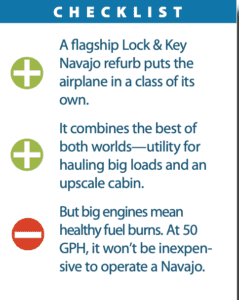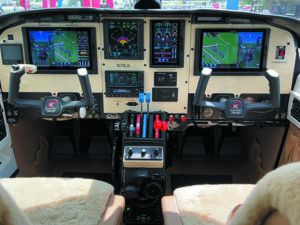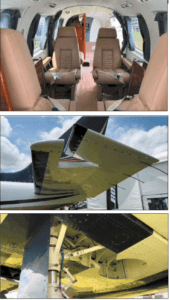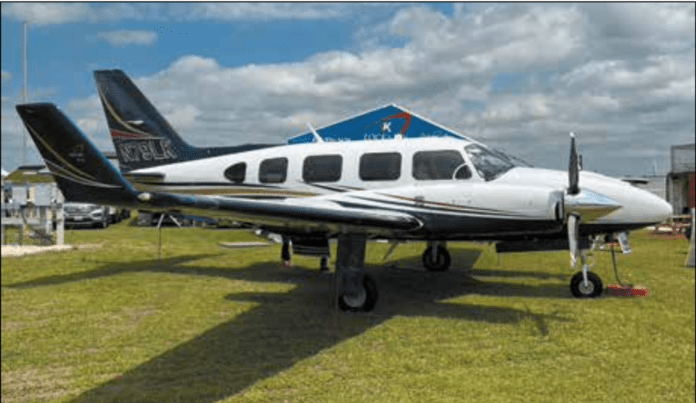If you had that kind of money to invest in a used twin-engine airplane—perhaps for a company aircraft making regional trips with staff and their stuff onboard—you might consider a small King Air, Piper Cheyenne or even an older Cessna Conquest. But step up into the world of turbine twins and you’re in the big leagues, with higher costs and demands for insurance (if you can even get insurance in the current market), intensive maintenance programs and of course the eye-widening fuel bill when the Jet-A truck comes around.
For those reasons, Mike Jones at Mike Jones Aircraft Sales makes a good case for his Lock & Key Navajo refurbishment. The non-pressurized Navajo won’t exactly be cheap to own, but compared to a pressurized turbine twin it can be gentler. Plus, since the Lock & Key is a thorough refurb—nearly as good as a new aircraft—it has a sizable advantage over aging complex twins and turbines when it comes to maintenance costs and dispatch reliability. It’s a ramp-looker with winglets, four-blade props and a high-end paint job. Plus, it has a classy cabin—all things a buyer would expect from an airplane with its price tag.

BETTER THAN THE ORIGINAL
That’s part of the appeal because the Lock & Key is loaded with performance mods you might not find on the average Chieftain Navajo. The original Lock & Key program of 17 years ago was based partly on equipping the airplane with a healthy amount of Colemill aftermarket modifications, and Jones eventually bought Colemill and the rights to the STCs that cover Navajos and a wide variety of aircraft. It starts with a low-time and well-kept airframe—something that’s not easy to find. Navajos are people- and freight-hauling workhorses.
The starting price for a renovated Lock & Key is $895,000, but options (a real Lock & Key) quickly send the price over $1 million. Jones said it simply costs a lot of money to make the airplane like new. The paint work on the airplane is $100,000 (and includes new stainless steel screw kits and cam locks), while over $100,000 is invested in the cabin—high-end cabinets, tray tables and even polished seat rails.
The refurb includes new interior and exterior windows and new carpeting, and the interior plastic components are covered in French-seamed leather. The plane gets a new Jentrol heater system and upgraded air conditioning system.

SYSTEMS, SHAKEDOWN
The roughly nine-month restoration of a “pedigree” Navajo starts with the good-performing Colemill Panther modification, which includes winglets. The airplane gets two factory-overhauled Lycoming 350-HP TIO-540 engines with alodined baffling, overhauled turbos, wastegates and magnetos, plus new hydraulic pumps, oil coolers and lines, alternator and high-speed starters. The fuel quantity system is upgraded with CIES digital fuel sensors and an Aerospace Logics fuel indicator.

To keep the cabin noise down, the airplane gets new Hartzell four-blade Q-tip propellers, new governors and a RAM prop syncing system. The cowlings are upgraded for better engine cooling and unlike stock Navajos, you can close the cowl flaps during climb for a 15-knot speed gain, according to Jones. The winglets are advertised to provide a 6 percent increase in climb performance, tighter aileron control and shorter landing rolls.
But above all, Jones, a veteran corporate pilot, firmly believes in the importance of good single-engine climb performance and safety, and the Lock & Key includes some safety-enhancing airframe tweaks. This includes thoroughly rebuilding the landing gear components and installing new hardware, while also modifying it to eliminate the inner gear door for faster cycle times and less drag for engine-out climbs.
The airplane gets new Garmin avionics, including the GFC 600 autopilot with Smart Rudder Bias, automatically sensing and applying the right inputs when an engine fails. For more yaw control, the airplane has empennage strakes.
The avionics upgrade doesn’t skimp on accessories. It includes a new circuit breaker bus, new LED lighting and new modernized overhead switches. Put together—including the new instrument panel—it’s about as modern as a retrofit avionics cockpit can get. Of course, if Piper made the Navajo today, the airplane would likely get a Garmin G1000 system, but in some ways I think the TXi display suite with GTN navigators, EIS and GFC flight control system is simpler—which could mean an easier transition for pilots stepping up.
One option offered during the refurbishment is replacing the aileron, rudder, flap and elevator skins—all internally coated with epoxy primer. All flight controls are rigged and reworked with new bushings and hardware. The airplane gets new Cleveland wheels and brakes.
After nearly a year of refurb work, the aircraft is signed off for an annual inspection and it’s professionally flown for roughly 40 hours to break in the engines and note any discrepancies and then brought back into the shop for another inspection. Each refub gets a two-year warranty.
FIT, FINISH, PERFORMANCE
Jones says the airplane (a “Bahamas station wagon”) is appealing to a certain customer who needs to haul a big load; the airplane can handle roughly 1050 pounds of payload after full fuel. There’s plenty of baggage space, with 700 pounds of total capacity (200 pounds in the nose baggage area and 300 pounds total in the wing lockers), plus the cabin accommodates up to eight seats, and there’s a private potty in the far-aft cabin.
Even the best modded Navajo won’t be a speed demon, so don’t expect turboprop speeds. Typical cruise is around 185 knots. Plan on a 50-GPH fuel burn for the first hour and 40 GPH thereafter, with an average range of 700 NM with IFR reserves.
“These aircraft absolutely will finance and appraise for the selling price,” Jones said. The airplane I looked at for this report (pictured here and in the video link to the left) recently appraised for $1.75 million.
See a video on the Lock & Key refurb at http://tinyurl.com/j95ht2a.


